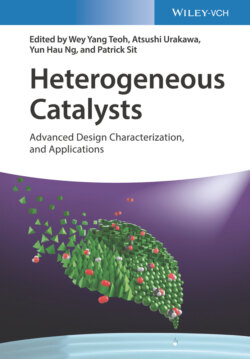Читать книгу Heterogeneous Catalysts - Группа авторов - Страница 46
4.2.1 Catalyst on Graphene Oxide
ОглавлениеGO offers unique properties such as near atomic thickness, scalable syntheses, the possibility of processing using solution‐based techniques, and facile deposition as nanothin films. Moreover, the primary properties such as flake size and quantity of oxygenated groups are tunable. The GO flakes are amphiphilic, containing variable quantities of aromatic domains besides the hydrophilic oxygenated groups. The most commonly accepted structure of graphene is based on the Lerf–Klinowski model (Figure 4.1) [6]. The model concludes that GO consists of two different randomly distributed domains: (i) pure graphene with sp2‐hybridized carbon atoms and (ii) sp3‐hybridized and oxidized carbon domains. In this model, the oxidized GO areas contain mostly epoxy and hydroxyl functional groups on the basal planes with carboxyl groups at the edges. The rich surface chemistry of GO is favorable as active sites for the design of metal‐free catalysts (carbocatalysts) as well as for the preparation of composite catalysts with metals. GO surface interacts with other GO flakes or other nanomaterials by chemical interactions or physical interactions, i.e. hydrogen bonds, van der Waals forces, and dispersive forces (π–π interactions). This makes the preparation of catalysts more straightforward and versatile than for other carbon materials, although a high degree of control has not yet been achieved on GO. The other advantage is that GO is highly hydrophilic, thus allowing the use of aqueous media for impregnation.
Figure 4.1 Structure of graphene oxide based on the Lerf–Klinowski model.
Source: Dreyer et al. 2010 [6]. Reproduced with permission of Royal Society of Chemistry.
To prepare supported metal catalysts on GO while preserving properties of the latter (i.e. high oxygenated group content), one should ensure the reduction of the metal precursor but avoid the overreduction of GO. Overreduction of GO leads to reduced graphene oxide (rGO) support. Therefore, mild reduction methods should be used to preserve GO surface chemistry. The nucleation of noble metal nanoparticles can be carried out by hydrothermal treatment without any reductant, microwave heating, or using mild reductants such as glucose. Depending on the reduction temperature, the resulting substrate may be retained as GO (at 25 °C) or converted to rGO (at 60 °C) [7]. Alternatively, the reduction of pre‐impregnated metal precursors can be carried out in the gas phase under flowing H2 at low temperatures (250 °C).
The main advantage of using GO as metal catalyst supports is that the oxygenated surface groups of GO naturally act as nucleation sites for nanoparticles, thus minimizing the aggregation. In that sense, the use of a capping agent that stabilizes bare metal nanoparticles can be mitigated. Moreover, GO can be functionalized with specific ligands such as dopamine that allow subsequent binding with metal nanoparticles [8]. The rich surface chemistry of GO makes it hydrophilic, and it can even catalyze side reactions. These reactions can be beneficial as a bifunctional catalyst in tandem reactions such as coupling followed by hydrogenation [9]. In the event that the reduction potential of the reductant is greater than that of pristine GO, another type of support, i.e. rGO, results, as will be explained in Section 4.2.2.1. To the best of our knowledge, the formation of single‐metal sites on GO has not been described yet, probably because the excessive density of nucleation sites prevents the isolation of single sites and favors the aggregation to metal nanoparticles.
